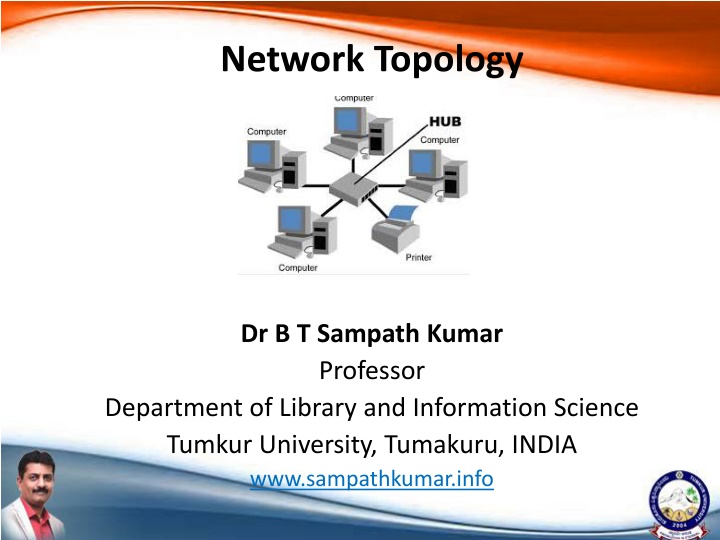
Network Topology and Popular Types Explained
Explore the fundamentals of network topology, including star, ring, and bus networks, with detailed explanations of advantages and disadvantages for each type. Discover the structure and characteristics of various network arrangements in this informative guide provided by Dr. B.T. Sampath Kumar, Professor at Tumkur University, INDIA.
Download Presentation

Please find below an Image/Link to download the presentation.
The content on the website is provided AS IS for your information and personal use only. It may not be sold, licensed, or shared on other websites without obtaining consent from the author. If you encounter any issues during the download, it is possible that the publisher has removed the file from their server.
You are allowed to download the files provided on this website for personal or commercial use, subject to the condition that they are used lawfully. All files are the property of their respective owners.
The content on the website is provided AS IS for your information and personal use only. It may not be sold, licensed, or shared on other websites without obtaining consent from the author.
E N D
Presentation Transcript
Network Topology Dr B T Sampath Kumar Professor Department of Library and Information Science Tumkur University, Tumakuru, INDIA www.sampathkumar.info
Network topology Network Topology is the schematic description of a network arrangement, connecting various nodes(sender and receiver) through lines of connection.
Types of topologies Star topology Bus topology Ring topology Tree topology Mesh topology
Star topology It consists of a central node, to which all other nodes are connected. The central node provides a common connection point for all nodes through a hub. Every node is connected to a central node called a hub or switch.
Advantages and disadvantages Advantages Good performance. Easy to set up and to expand. Any non-centralized failure will have very little effect on the network. Disadvantages All nodes are connected to main computer. Expensive to install. Extra hardware is required.
Ring network In case of ring network, each node connects to exactly two other nodes, forming a single continuous pathway for sending data through each node.
Advantages Very orderly network where every device has been connected. Performs better than a bus topology under heavy network load. Does not require a central node to manage the connectivity between the computers.
Disadvantages Data packets must pass through every computer between the sender and recipient therefore this makes it slower. If any of the nodes fail then the ring is broken and data cannot be transmitted successfully. It is difficult to troubleshoot the ring. Troubleshooting is a form of problem solving, often applied to repair failed products or processes.
Bus network In this type of topology where all the nodes (computers as well as servers) are connected to the single cable (called bus). Every workstation communicates with other device through this Bus.
Advantages Easy to implement and extend. Cable length required for this topology is the least compared to other networks.
Disadvantages If the main cable (i.e. bus ) encounters any problem, then the whole network breaks down. It is difficult to detect and troubleshoot fault(s) at individual station.
Tree topology In this topology two or more hubs and/or computers are connected to one another in a succession of levels.
Advantages It is an extension of Star and bus Topologies. Expansion of Network is possible and easy. The whole network has been divided into segments, which can be easily managed and maintained. If one segment is damaged, other segments are not affected.
Disadvantages As more and more nodes and segments are added, the maintenance becomes difficult.
Mesh network A mesh network topology is a decentralized design in which each node on the network connects to at least two other nodes.
Advantages Data can be transmitted from different devices simultaneously. This topology can withstand high traffic. Even if one of the components fails there is always an alternative present. So data transfer doesn t get affected. Expansion and modification can be done without disrupting other nodes.
Disadvantages Set-up and maintenance of this topology is very difficult. Even administration of the network is tough.
